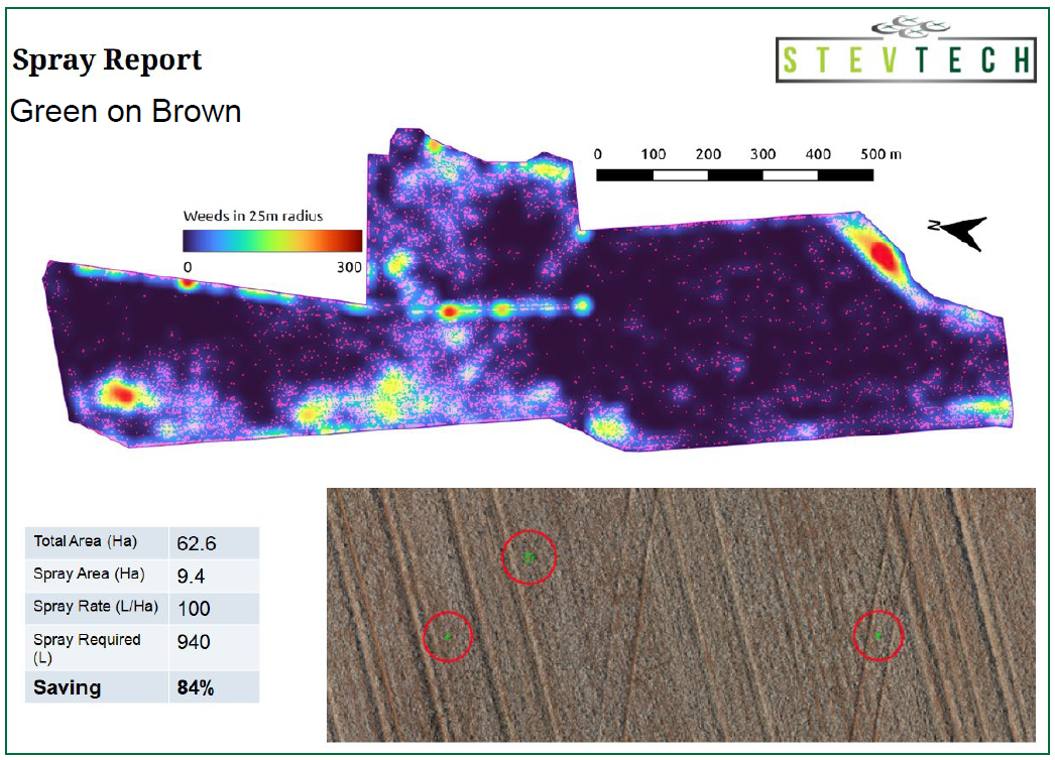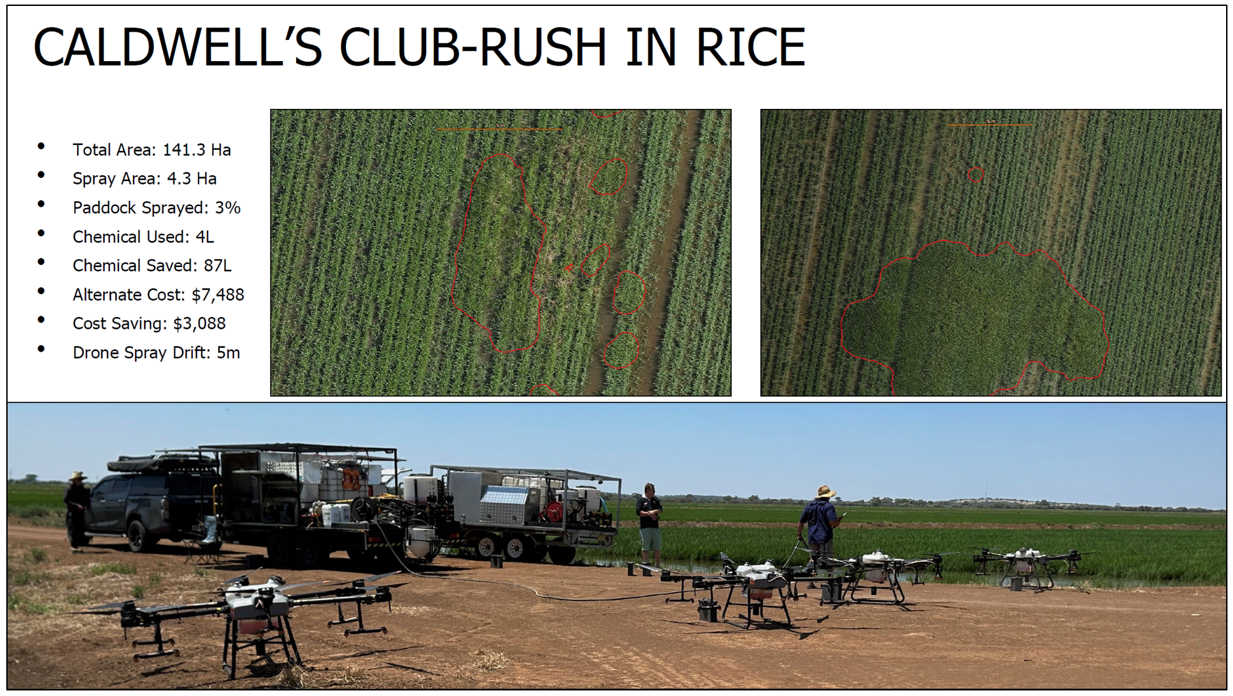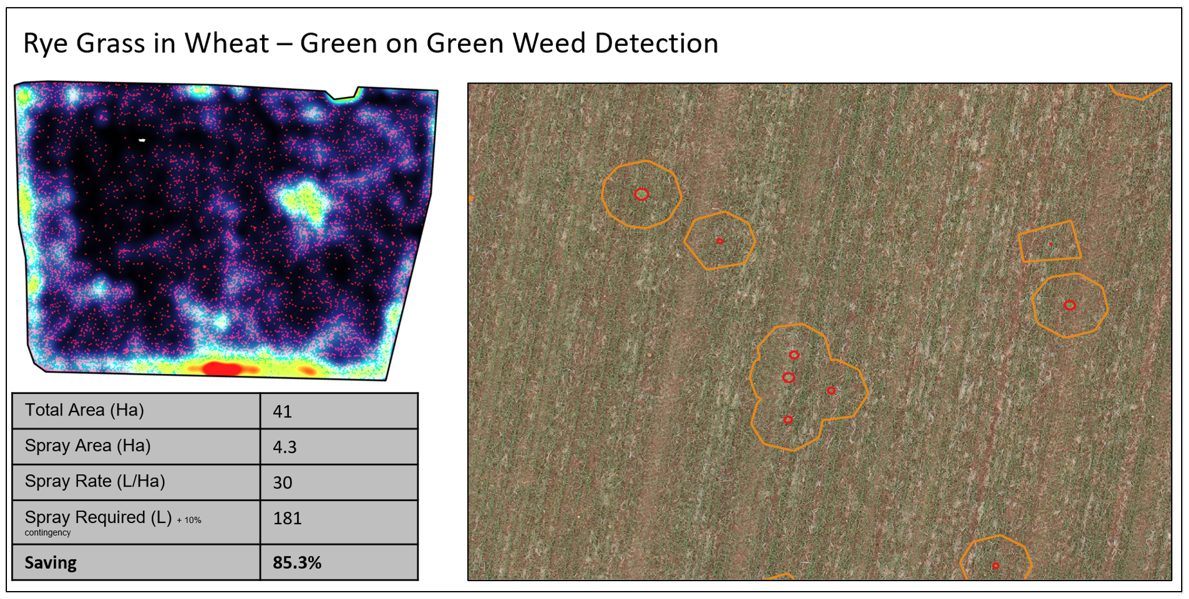Drone docking stations and weed detection
Author: Tristan Steventon (StevTech) | Date: 16 Feb 2024
Take home message
StevTech Pty Ltd has a fully autonomous drone docking station that can be deployed on farm for the duration of a growing season or for specific crop risk periods. The drone, which lives within the weatherproof dock and is controlled from an operations centre at StevTech HQ, deploys from the dock and collects ultra high-resolution imagery (+/- 1cm pixel). On return to the dock the data is transferred via satellite internet to the cloud where it is processed using StevTech machine learning techniques. In the case of weed detection data, it is then sent directly to the grower’s spray rig for application. See below for some examples of previous green on green and green on brown weed detection work.
Why is this necessary
Farm size has almost doubled in the last 30 years. Individual agronomists are managing larger client bases and servicing very large areas, travelling vast distances. Increasing herbicide resistance, the price of chemical and the aforementioned increasing scale of Australian farms are fuelling innovation in sensors and technology to automate the detection and destruction of weeds. StevTech is part of this innovation drive, and this year will deploy a fully autonomous drone docking station with weed detection capabilities that can integrate directly with on-farm GPS guided spray equipment as part of a GRDC funded project. Weed detection is only one part of the solution which will also include early warning for pest, disease and nutrition issues without the need for a human crop scout.
Figure 1. Example of green on brown weed detections using a drone and integrated into a John Deere SP spray rig.
Figure 2. Green on green detection of a weed in rice and integrated into spray drones. Drift was measured to be less than 5m during application.
Figure 3. Green on green weed detection of rye grass in early wheat crop.
Figure 4. StevTech examples of early warning for pest, disease, nutrient deficiency and weeds using machine learning and image recognition techniques.
Figure 5. Top left: Remote operations centre. Top right: Inside the docking station.
Bottom: The docking station preparing for transportation.
Cost comparison vignette
A grower in Central West NSW requested StevTech identify fleabane within a 180 ha paddock late in fallow to allow for a high rate of chemical to be applied to these plants given their size. The plants had not been controlled by earlier sprays and required a double knock from two separate chemical mixes.
StevTech was able to map the paddock and the grower was able use the same map for both spray applications. Other growth had been controlled effectively during fallow. Cost analysis below:
Table 1. Cost benefit table of chemical costs using StevTech compared to blanket spraying
Task | StevTech cost based (per ha) | Chemical cost based on per ha rate |
|---|---|---|
Blanket Spray 1 | $0 | $15/ha ($2700) |
Blanket Spray 2 | $0 | $12/ha ($2160) |
Total for blanket spray option | $4860 | |
First spray using StevTech map | $7/ha ($1260) | 87% saving on chemical. |
Second spray using StevTech map | $0 | 23.4ha x $10=$234 |
Total cost for StevTech option | $351 + $234 + $1260 = $1845 | |
Costs/benefit on 180ha paddock | $3015 cheaper | |
Cost benefit if conducted across 2000ha | $54,000.00 vs $21,020.00 | |
+$32,000 better off | ||
GRDC autonomous agronomist project 2024
Grain Automate is a new initiative from GRDC within the scope of GRDC’s new 2023-2028 RD&E plan. Grain Automate will be a portfolio of new research, development, and extension (RD&E) investments aimed at delivering outcomes for Australian grain growers in machine autonomy and intelligent systems. It complements GRDC’s existing investment programs in precision agriculture, digital agronomy, and advanced analytics.
Data Farming Australia has received funding from GRDC to answer the question “Can we automate agronomy in a way that increases agronomic efficiency, enables better interaction and communication between farmers and agronomists, and supports more timely and precise field actions?”
For the project a 100ha field will be selected with the aim of providing all agronomic recommendations for a complete fallow and cropping cycle without the agronomist entering the paddock. This concept is similar to the ‘hands free hectare’ that was trailed in the UK, however in this case, the focus will remain on the agronomic management decisions and the interaction with technology including the communication between the grower and agronomist required to achieve this.
StevTech has been selected to deploy our ’drone in a box’ system for this project and it will be used to complete crop checking during the entire season. This piece of technology will be fundamental to the project as it provides extreme high-resolution images and video of weeds, pests, diseases, and nutritional disorders that the agronomist would normally be scouting for in the field. The potential future integration at this point is in machine vision integrations which automatically calculate severity levels of infestations and present recommendations.
Once the data has been collected and sent back to the ‘agronomy control room’, a trained agronomist will review the images and results from the inspection. The processed outputs of this data will then be sent to autonomous ground robots (SwarmFarm and similar) to complete in-field tasks such as weed spraying.
Legislation relating to Autonomous Drone Flight
StevTech is in the final stages of having approval for the use of a Drone in a Box that is controlled from a remote operations centre. This has been a lengthy process however one of the aims of the Autonomous Agronomist Project with GRDC is to demonstrate the ability, (or inability due to legislative boundaries) for this type of operation. It is hoped that this project will encourage CASA to consider the sensible application of drone legislative requirements within an industry that would benefit greatly from the increased and more streamlined use of drones and the high-quality data that they produce.
Conclusion
StevTech’s drone docking station solution is built upon the last 6 years of StevTech weed detection R&D and commercial operations. The completely autonomous nature of the docking station takes away the hassles of having contractors coming on farm, or the time-consuming nature of collecting drone data yourself. It is present in your paddock like a weather station or soil probe and provides early warning and high value data sets on demand.
As farms get bigger, quality labour becomes increasingly scarce, and chemical prices rise, the StevTech docking station may be part of the on-farm solution to meet these challenges.
Contact details
Tristan Steventon
StevTech
Dubbo
Ph: 0468 707 523
Email: tristan@stevtech.com.au
Date published
February 2024
GRDC Project Code: DFL2312-001RTX,
Was this page helpful?
YOUR FEEDBACK





